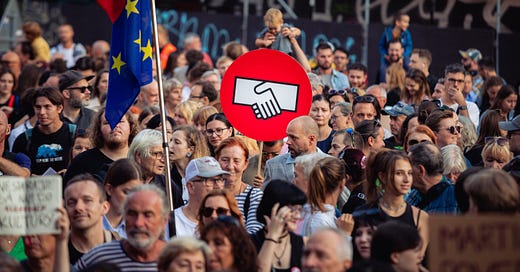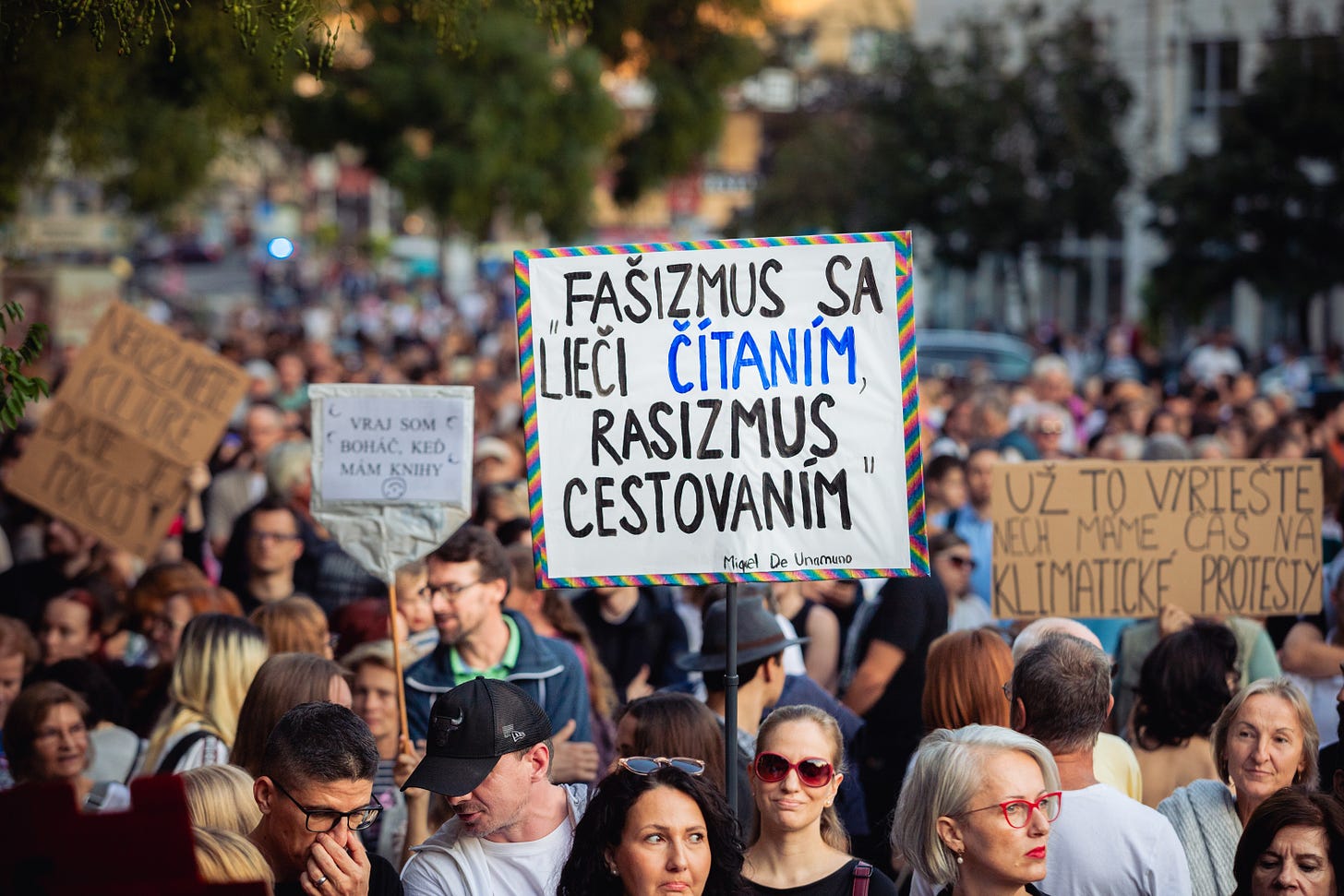The Purge: Why Slovakia's cultural community is taking to the streets
On the rise of authoritarianism in Europe and the ways in which the cultural community is resisting.
This week I’m back in Belgrade for BITEF (the Belgrade International Theatre Festival), a festival I’ve attended regularly for several years, though this year I am very excited to be on the jury. The opening address will be given this evening by Milo Rau, whose show Antigone in the Amazon forms part of the main programme. I recently spoke to Rau for Green European Journal about the upcoming Austrian elections, which the look set to win, and about the rise of the far right in Europe, something which this week’s newsletter will also touch upon. You can read the full interview here.
Café Europa is free to read. I set it up to - hopefully - make connections between different theatre scenes across Europe and want to keep it accessible, but it also takes a lot of time to research and write. If you’d like to help support my writing, please share it with others who might like it or consider becoming a paid supporter.
On 19th September, more than 3,500 cultural workers took to the streets of Bratislava. This was part of a nationwide protest in response to recent decisions made by the country’s Culture Minister Martina Simkovicova. According to the organisers, approximately 10,000 people attended protests in 14 cities in Slovakia.
What prompted this? Things came to international attention earlier this year with the dismissal of Matej Drlička, from his role as director of the Slovak National Theatre, in August, which was followed a day later by that of the director of the Slovak National Gallery. As outlined in this Guardian article, they were just the most prominent names in a wave of dismissals that had taken place under Simkovicova, who as member of the right-wing SNS party, is part of the coalition led by populist Prime Minister Robert Fico.
Many see this as a calculated attempt to clean up the cultural sector of figures who have been critical of the government. Drlička’s “activism” was one of the reasons cited for his dismissal (along with an incident involving a falling chandelier in which no one was hurt). Other people ousted from their positions, include the board of the Slovak Fund for the Promotion of the Arts, essentially paralysing arts funding the country.
The response of Slovakia’s cultural community has been to get organised and take collective action. The Culture Strike Committee was established, and, in September, a strike “alert” announced. While no actual strike action was taken, it was intended as a way of drumming up publicity for their plight. A set of demands were made of the Ministry of Culture, who they accuse of targeting cultural workers and creating widespread financial insecurity in the cultural sector. They are calling for an end to “ideologically motivated censorship” and for the financial stabilization of the sector. If there demands are not met, further more disruptive actions will be taken. So far, no politicians have responded to the Cultural Strike Committee's call for a meeting.
Beyond the dismissal of artistic leaders, one of the key issues fuelling the protests as is what is viewed as catastrophic mismanagement of the country’s cultural funding. “The Ministry of Culture is fundamentally failing in its funding schemes,” according to Jana Alexová, spokesperson for the Committee. In two of the country’s cultural subsidy programmes - Renovate Your House, a programme for the restoration of monuments, and Culture of Disadvantaged Groups, a cultural integration programme – these delays have had, according to Alexova, “devastating consequences.”
“Public support through the Slovak Arts Council has been paralysed due to a delayed timetable, resulting from ministerial nominees repeatedly absenting themselves from board meetings where new calls were to be announced. A similar paralysis threatens support for audio-visual works from the Audiovisual Fund, where no projects can be approved without the votes of all the ministerial nominees,” she explains.
The Ministry of Culture, under Simkovicova, has repeatedly expressed its desire to focus on “traditional values” and to reject anything that deviates from what it considers “the norm.” Simkovicova has expressed outrage over a painting of two men kissing by the Slovak artist Andrej Dúbravský. She’s also been vocally critical of drag workshops and LGBTQ organisations in general, threatening to defund them, though some view this as just a way of clamping down on independent spaces and artistic freedom.
Obviously, parallels can be drawn with Hungary and Viktor Orbán’s crackdown on diversity in media and the arts. The Hungarian theatre sector is dominated by Attila Vidnyánszky, artistic director of the National Theatre and someone with close ties to Orban. Hungarian theatre makers have described him to me as gatekeeper, and say that it’s all but impossible to get work made without his approval, while the independent scene is increasingly squeezed - this SEEstage article provides an interesting overview of the Hungarian independent scene. Hungary spent more on the Theatre Olympics, which took place last year in Budapest (an event which honked of culture-washing, though this did not prevent many renowned theatre makers from participating), then it did on its domestic independent scene. Is Slovakia going down that path? In that Guardian article, Drlička wasn’t so sure, commenting that “if Hungary is the goal, these are not the right people in charge. They are not that smart.”
However, in July the public broadcaster, RTVS was put under direct control of the Ministry of Culture and such a swift and crude removal of numerous artistic leaders is nothing if not worrying. In this Guardian piece, John Kampfner outlines the ways in which Slovakia has slid further towards authoritarianism after Fico’s shooting earlier this year. In response to Drlička’s dismissal, Milo Rau, now director of the Wiener Festwochen, wrote an open letter to Robert Fico, which stated that: "where you start to measure the work of experts by the yardstick of political compliance - and where this is lacking, to speak of "activism" - democratic society ends and, with it, artistic freedom."
Austria, obviously, has its own elections coming up this weekend, which the far right FPÖ looks likely to win. In its campaign material, it vowed to re-evaluate its spending on cultural organisations, stating that “it is unacceptable that artists who have shown themselves to be critical of measures during the coronavirus crisis are treated like lepers by the cultural elite, while ‘woke events’ such as the so-called ‘Song Contest’ or the ‘Wiener Festwochen’ are financed with compulsory levies.”
In among the frothing about immigration, the government’s Covid 19-prevention measures (also a bugbear in Slovakia), and - favourite American culture war import - drag queens in preschools, there’s a palpable distaste for all forms of culture deemed ‘woke’ or degenerate, which seems to apply to most things that deviate from traditional Austrian music and art. When I spoke to Rau, he wondered if those voting for the FPÖ had actually read all their campaign material: “Do they really want to only listen to trumpet music forever?”
You see this replicated in Hungary and Slovakia and increasingly other countries too, a focus on traditional and folk culture - things that should, of course, be celebrated and preserved - but it’s always with an undercurrent of nationalism, that these are the only valid forms of culture, and the implicit suggestion that anything that deviates from this is a threat.
Rau’s response to the threat posed by the FPÖ has been typically robust. Together with Nobel-winner Elfriede Jelinek, whose once-banned play Burgtheater he will direct at the Burgtheater in Vienna next year, he mounted a campaign - and explicit appeal to stop the FPÖ- and put together a public tour including dates in Stockholm and New York to draw attention to the ramifications of an FPÖ win and ways in which the arts community, in which society, can resist.
In his keynote address at the International Conference of the ITI in Antwerp last week, he said: “The appeal by Elfriede Jelinek and me, directed against the nationalist, anti-art election program of the FPÖ, is a cry for help from civil society. Because art must remain free, that is to say: complex – diverse and unpleasant, radiant and confusing like reality itself.” (You can read the full speech here).
In the UK, it can be easy to feel that all this is happening somewhere far away, somewhere over there in the middle of Europe, but just last week we saw the cancellation by Manchester Royal Exchange of a version of A Midsummer Night’s Dream set in the city’s rave scene. Its entire five-week run was called off at the last minute because of references to the Israel-Gaza conflict and trans rights, which allegedly the management wanted removed. The UK might not have the kind of overt ideological interference we see in Hungary and Slovakia, but instead there is a culture of gratitude tactics and self-silencing, a theatre scene stretched so thin that it can’t risk kicking up a stink – and that is something about which we need to be vigilant.
This week in European theatre
A round-up of festivals, premieres and other upcoming events over the next seven days
BITEF – As mentioned above, the Belgrade International Theatre Festival opens tonight. The second edition under the artistic directorship of Nikita Milivojević and his co-selectors Ksenija Đurović and Tijana Grumić, it features a mix of international big-hitters like Tiago Rodrigues’ Hecuba, Not Hecuba, as well as an intriguing programme of relatively small-scale and independent work from artists in the region, including the magnificently titled, We Are Going to Make Something about War, Gender and Liberty, It Will Be Titled: What Would Chelsea Say. It runs until the 4th October.
Dublin Theatre Festival – This year’s festival features a cracking mix of Irish and international work including the world premiere of Safe House, a new piece of gig theatre by Enda Walsh and composer Anna Mullarkey, Druid’s production of Tom Murphy’s classic play The House, Forced Entertainment’s Signal to Noise, Kate Heffernan’s Guest Host Stranger Ghost – a performance designed to be staged on the sets of other productions in the festival - and ANU’s new show Starjazzer, based on a story by Sean O’Casey and staged in the intimate environs of Dublin’s National Library of Antiquities (which I covered in detail last week). The festival runs from 26th September – 13th October.
Faith, Money, War and Love – The Schaubühne’s autumn season gets underway with the world premiere of a new work by Robert Lepage, created with the ensemble through a process of improvisation and spanning eight decades of German history. It opens in Berlin on 29th September.
Thanks for reading! If you have any feedback, tips, or thoughts about this newsletter, you can reach me on natasha.tripney@gmail.com







